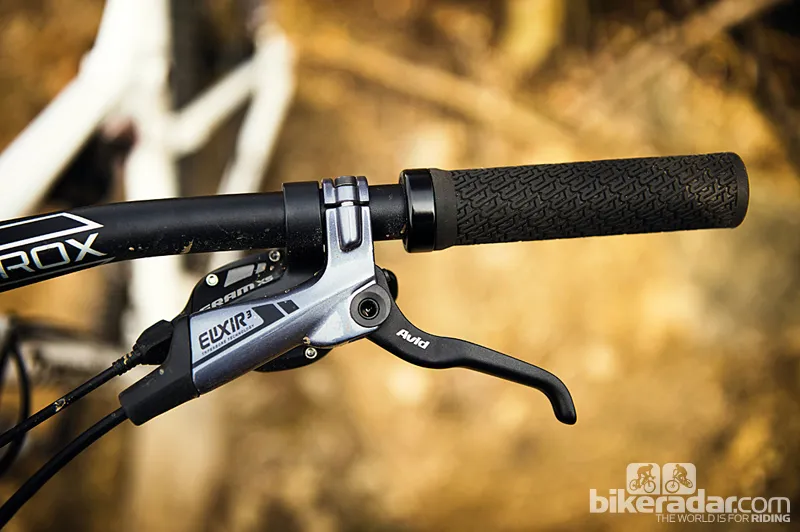Transition pride themselves on practical, ‘fun first’ machines, and the 26in-wheeled Bandit was one of our favourite bikes from last year – a zippy, playful trail hooligan with a touch of custom class. So, can the 29er version add speed and smoothness without losing that essential Transition spark?
Ride & handling: Great performance for the money
We’re sometimes cynical about the BMX cliché of rider-owned companies and their marketing statements. However, there’s an immediate honesty and connection with the big-wheeled Bandit that shows those words aren’t empty when it comes to Transition.
The key thing about the Bandit is that it’s never too twisty or twangy for comfort, so the thru-axle ends never suddenly unload and whip you into the weeds. Once you’re used to pushing each control input a bit deeper and holding it a bit longer, its more compliant feel helps take the edge off the shock stubbornness at higher speed and on rougher trails.
The wobble and twist is more obvious and less forgivable when you’re trying to thread that big front wheel through tight tree lines while grunting the power down on a rocky climb.
On less testing climbs it’s fine. While at just over 13.6kg (30lb) it’s on the cusp of chubby, but on par with obvious competitors such as Norco’s Shinobi. Again the shock firmness meant we never felt as though we were digging the back wheel out of sand in slow rev/high torque moments out of bogs or climbing switchbacks, and we didn’t even want for any sort of lockout lever when taking the easy fireroad options back to the top.

Transition Bandit 29 3
Also, the generous length – even in this Medium size – means plenty of breathing space for extended climbs.
The Recon Gold fork might be a pretty basic unit, but the position it puts the wheel in is spot on for a relaxed and easy confidence, even as you peel out of the car park and onto the trails.
The simple rebound-only Monarch shock also impresses from the off. With no compression options to worry about (or to muddy the damping waters) it actually gives us a far more balanced and predictable tune in a lot less time than the full-spec Monarch RT3 we’re testing, on a very similar bike, at the same time.
The suspension action is a good match for the damper, with typical RockShox stubbornness over small bumps offsetting the tendency of low-pivot swingarm bikes to squish and bounce with a more active damper.
The neat little swing link under the top tube also produces an impressively linear – but not too doughy – stroke once you start working it harder. Simple damping circuitry means it’s still relatively firm and prone to indigestion at higher speeds or on more hectic trails.
The feel is very well matched and predictable at both ends, so it never unsettled our confidence; it just pumped our arms up faster than a top-spec RockShox or Fox-equipped bike does on extended rough or rock-studded downhills.
Transition’s targets for this bike are trail riders looking for more technical descending capability, and their aim is spot on.
Frame & equipment: Good value but we’d recommend a custom build
The 140mm Covert 29 is Transition’s dedicated all-mountain (AM) big wheeler, so some compromise is obvious in the trail-focused Bandit. While a 15mm axle fork and tapered head combine with 142x12mm screw-thru dropouts at the rear to keep the wheels precisely placed, there is noticeable twist through the relatively skinny hydroformed frame.
The resulting feeling of outwards bulge through aggressively railed corners – and an approximate attitude to line choice through rocks and roots – is obvious compared to the stiffest bikes in the category.
The rigid-versus-pliable-frame argument, and what it does for traction/feel/rider fatigue is hotly contested in every two-wheeled sport from mountain biking to MotoGP.
With 130mm front and 120mm rear on the 29 – compared to 140mm front and 130mm rear on the 26er – you’re definitely not losing much travel by switching to bigger wheels.
The stumpy, resolutely rigid cold-forged Truvativ stem and big 740mm Kore riser bar on this, the cheapest of three build kits, reinforces the fact the Bandit is no limp-wristed cross-country rig either.
Chain guide mounts mean that such rattling doesn’t have to mean dropped chains and flow-killing faffing, and there are dropper post guides for the most obvious upgrade it deserves.

The frame is pliable rather than unyielding
Compared to most boutique-brand bikes the Transition 3 is definitely a good deal, with frame and shock retailing for £1,400/US$1,699. There’s nothing in the neatly welded, anodising-trimmed, crash replacement-covered frame to make is seem cheap either.
The transmission and brake spec is basic though, and having slid all over the place on the crap plastic tyres and stretched our sleeves with forearm pump from the basic shocks of the 3, we reckon it’s worth saving up for the Bandit 2. That gets a Fox Kashima fork and shock, plus tyres in a proper compound, for a reasonable premium.
This article was originally published in What Mountain Bike magazine, available on Apple Newsstand and Zinio.







